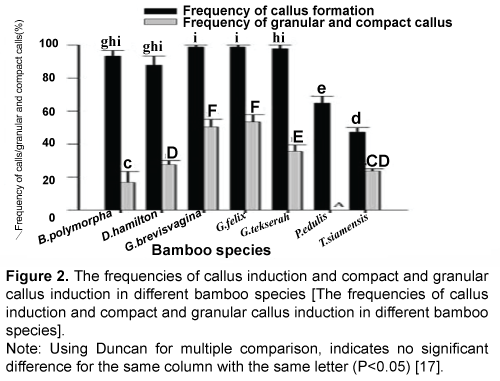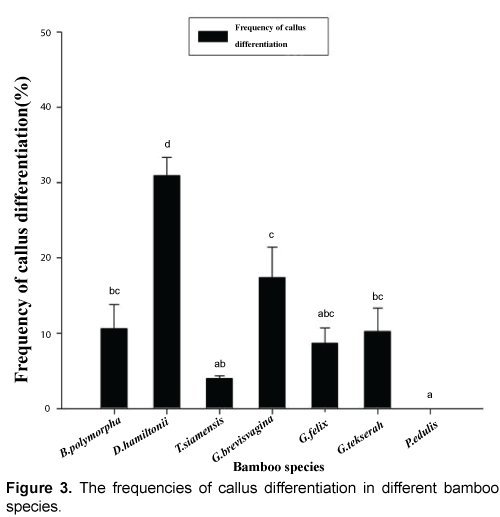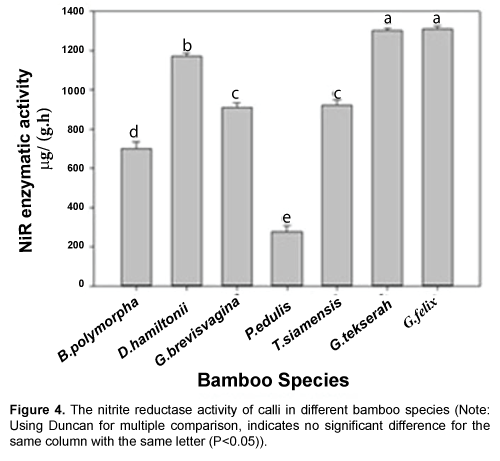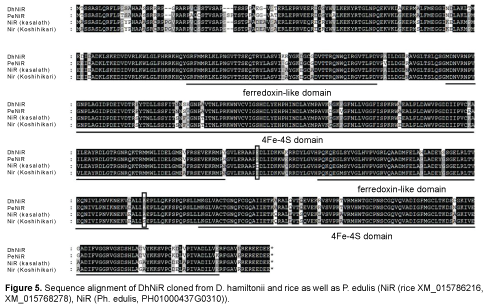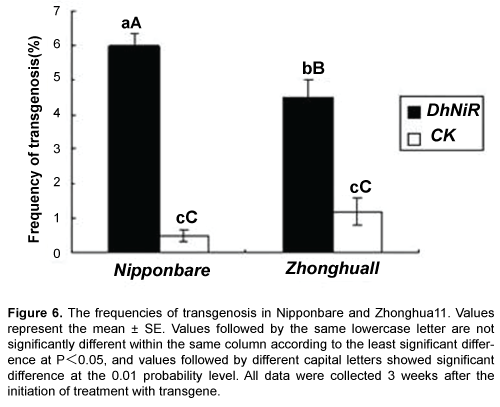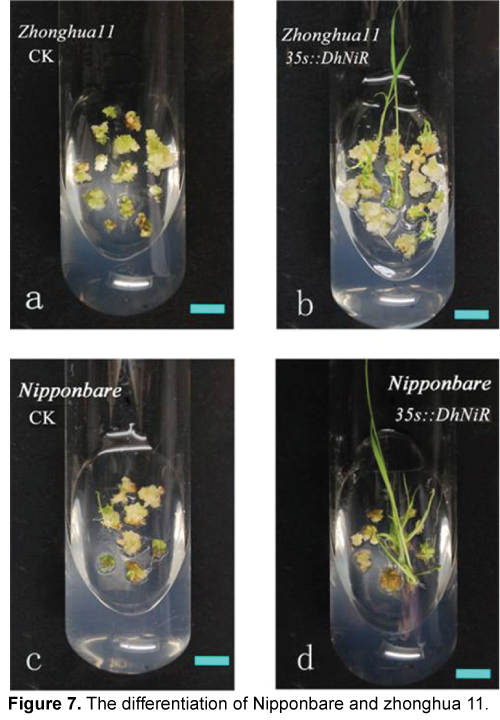Xiaomei Guo1, Lifen Ji1,2, Longfei Zhu1, Lilin Song1, Shinan Liu1, Qiaolu Zang1 and Xinchun Lin1,*
1The Research Center for the State Key Laboratory of Subtropical Silviculture, Zhejiang Agriculture and Forestry University, Zhejiang, 311300, China;
2Ruzhou Municipal Bureau of Housing and Urban-Rural Development in Ruzhou, Henan, 467500, China.
- *Corresponding Author:
- Xinchun Lin
The Research Center for the State Key Laboratory of Subtropical Silviculture
Zhejiang Agriculture and Forestry University
Zhejiang, 311300, China
Tel: +86-571-6374-3863
E-mail: linxcx@163.com
Received date: April 26, 2016; Accepted date: June 10, 2016; Published date: June 17, 2016
Citation: Guo X, Ji L, Zhu L, et al. Preliminary Research on NiR Gene Associated with Regeneration Capacity in Bamboo. Electronic J Biol, 12:3
Keywords
Bamboo; NiR enzyme; Regeneration ability; Gene transformation.
1. Introduction
Bamboo is a kind of important non-timber forest resources in Asia. It grows fast and has strong carbon fixation capability, which leads to much attention in terms of ecological and economic value. Meanwhile, bamboo has long juvenile phase and its flowering period is unpredictable, it is difficult to develop marketable bamboo cultivars by traditional crossbreeding method. Therefore, it is highly desirable to develop an efficient genetic transformation system for bamboo while this depends on the availability of an efficient regeneration system [1].
Bamboo plantlets were first regenerated from mature embryos of Bambusa arundinacea via somatic embryogenesis [2]. Subsequently, various explants were used to regenerate bamboo plantlets and a number of bamboo regeneration systems were reported [3-5]. However, lots of bamboo species still fail to establish regeneration systems due to their low regeneration ability. Meanwhile, high regeneration ability is also required for a stable transformation system. Therefore, research on bamboo regeneration capacity will lay a foundation for the successful genetic transformation and the development of valuable bamboo cultivars.
Regeneration ability of plant tissues was controlled by many factors and its relevant pathways were complicated, and the molecular mechanism of regeneration remained elusive. A number of genes involved in the regeneration process had been cloned, but only a few genes such as AtLEC1, AtWUS, OsSERK1, OsNiR and Os22A were further investigated on their function [6].
Nitrate assimilation mediated by the ferrodoxin-nitrite reductase (NiR) was an important process in rice regeneration. The NiR gene encoding NiR enzyme in the high-regeneration rice strain Kasalath showed high NiR enzymatic activity, while revealed low NiR enzymatic activity in the poor rice line Koshihikari, which indicated that the NiR enzymatic activity was correlated with the regeneration ability in rice [6]. When the NiR gene encoding high enzymatic activity was transformed into the low-regeneration rice strain, the regeneration ability of poor rice line had been significantly improved [7]. Bamboo and rice both belong to the same grass family (Poaceae); it is unknown whether the bamboo NiR-like gene is also associated with the regeneration capacity during bamboo regeneration process
In this study, the level of NiR enzymatic activity in different bamboo species was analyzed and the NiR gene from Dendrocalamus hamiltonii with high regeneration efficiency was cloned and transformed into rice to analyze its function on the regenerative capacity. Our data provide useful information for establishing the bamboo regeneration and transformation systems.
2. Materials and Methods
2.1 Plant materials and tissue culture conditions
Seven kinds of bamboo species for regeneration analysis were shown in Table 1, and their mature zygotic embryos were used as explants. After washing in running tap water for 10 h, their seeds were sterilized by immersion in 70% alcohol for 30 s and followed by immersion in 2.5% sodium hypochlorite for 30 min. The seeds were then rinsed 5 times with autoclaved distilled water, and the embryos were dissected out and inoculated on tissue culture media. All in vitro tissue cultures for callus induction and growth maintenance were incubated at 25âÃâÃÆ in the dark, callus differentiation and subsequent plantlet growth occurred under a 16/8-h light/dark photoperiod with light supplied at an intensity of 30–50 μmol m-2 s-1 [1].
| Genus | Species | The location of collection |
|---|---|---|
| Bambusa | B. polymorpha | China Yunnan |
| Dendrocalamus | D. hamiltonii | China Yunnan |
| Gigantochloa | G. brevisvagina G. tekserah |
Thailand |
| G. felix | China Yunnan | |
| Phyllostachys | P. edulis | China Guangxi |
| Thyrsostachys | T. siamensis | Thailand |
Table 1. Species of bamboo used for the experiment.
2. 2 Callus induction.
Zygotic embryos were cultured in the MS medium supplemented with 500 mg/L proline, 500 mg/L glutamine, 500 mg/L casein hydrolysate, 30 g/L sucrose and 8 g/L type A agar. In addition, 3 mg/L 2, 4-dichlorophenoxyacetic acid (2, 4-D) was used for callus induction (pH=5.7). Callus subculture was carried out at an interval of 3-week.
2. 3 Callus propagation
After 30 days, calli in the induction medium were transferred to the MS medium supplemented with 500 mg/L proline, 500 mg/L glutamine, 500 mg/L casein hydrolysate, 30 g/L sucrose, 8 g/L type A agar and 0.1 mg/L 2, 4-D (pH=5.7). Callus subculture was carried out a 4 weeks interval.
2.4 Callus differentiation
After 30 days’ propagation, calli were cultured on the MS medium with 30 g/L sucrose, 3 g/L gelrite, 2 mg/L benzyladenine (BA) and 2 mg/L kinetin (KT) (pH=5.7) for subsequent differentiation.
2.5 Regeneration ability analysis
Zygotic embryos were cultured in the induction medium and then transferred into the propagation medium and differentiation medium [8]. Each treatment consisted of three replications of 30 explants for each bamboo species. We quantitatively measured the frequency of the callus induction and the frequency of the granular and compact callus induction as well as frequency of the callus differentiation. They were calculated as follows:
Frequency of the callus induction=Number of calli/ Total seed embryos inoculated.
Frequency of the granular and compact callus induction=Number of granular and compact calli/ Total number of calli.
Frequency of the callus differentiation=Number of differentiated calli/Total number of calli
SPSS 17.0 and SigmaPlot ver. 8.0 (Systat Software, San Jose) were used to create figures.
2.6 NiR activity analysis
Granular and compact calli of 7 kinds of bamboo species with different regeneration ability (Table 1) were selected for NiR enzyme activity analysis, the method was according to the previous report [9]. Five samples per treatment were taken and the experiment was repeated for five times.
2.7 Clone and sequence analysis of NiR gene in D. hamiltonii and P. edulis
Total RNA was extracted from leaves of D. hamiltonii using RNAiso-plus (TaKaRa, Dalian, China) following the manufacturer instructions. The cDNA was synthesized by cDNA synthesis kit (TaKaRa, Dalian, China) following the protocol. The candidate NiR gene PH01000437G0310 was identified by blasting the transcriptome library of P. edulis using OsNiR gene as a reference [10]. The specific primer for cloning DhNiR was in Table 2. Sequence alignment was carried out by MEGA 4.
| Primer | Sequence |
|---|---|
| PeNiR primer F | ATGACATCCTCAGCCTCCCTGC |
| PeNiR primer R | CTATTCCTCATCCTCCTCCCTCTCC |
Table 2. Primers’ sequences for gene amplification.
2.8 Rice transformation and data analysis
The full-length ORF of DhNiR was cloned into the binary vector pCAMBIA1301 under the control of the cauliflower mosaic virus (CaMV) 35S promoter while the binary vector pCAMBIA1301 was used as a control. The rice transformation method and culture condition were according to the previous report [11]. 300 calli were used to transform and this experiment was repeated 3 times.
For Frequency of the callus transformation it was calculated as follows.
Frequency of the callus transformation=Number of transformation calli/Total number of calli.
Statistical analysis was carried out by using SPSS 11.5 and SigmaPlot ver. 8.0 (Systat Software, San Jose). Differences between the means were analyzed with one-way ANOVA followed by Tukey's test.
3. Results and Discussion
3.1 Regeneration ability in different bamboo species
Three types of calli were observed in mature embryos of the seven kinds of tested bamboo species. TypeâÃâ¦Ã calli were compact, granular, and creamyyellow (Figure 1a), which can differentiate into plantlets and be selected for the following subculture. Type âÃâ¦Ã¡ calli were watery, soft and white (Figure 1b). Type âÃâ¦Ã¢ calli were hard, and non-embryogenic (Figure 1c). TypeâÃâ¦Ã calli possessed a great capability to proliferate and differentiate, while Type II and Type III calli were difficult to differentiate.
As shown in the Figure 2, B. polymorpha, D. hamiltonii, P. edulis, Gigantochloa brevisvagina, G. felix, G. tekserah and Thyrsostachys siamensis could induce granular and compact callus. For frequencies of the callus induction and the granular and compact callus induction, callus induction rate of B. polymorpha occupied 93.34%, compact callus induction proportion were 16.67%. Callus induction rate of T. siamensis was 47.22%, compact callus induction rate accounted for 23.61%. Callus induction rate of D. hamiltonii occupied 90% and compact callus induction proportion was 27.57%. In P. edulis, the frequency of callus induction was 70.44% and no compact callus produced. Overall, callus induction rates of three kinds of species of Gigantochloa were all over 87% and corresponding rates of compact calli were over 27%.
The frequencies of the callus differentiation of different kinds of bamboo species were showed in Figure 3. The frequency of D. hamiltonii was the highest, followed by G. brevisvagina, B. polymorpha, G. tekserah, G. felix, T. siamensis and P. edulis. The callus differentiation abilities of tested bamboo species were significantly different with each other. In conclusion, D. hamiltonii had higher capacity to form regenerated plantlets.
Figure 2:The frequencies of callus induction and compactand granular callus induction in different bamboo species [The frequencies of callus induction and compactand granular callus induction in different bamboo species].
Note: Using Duncan for multiple comparison, indicatesno significant difference for the same column with the same letter (P<0.05) [17].
Under certain conditions, differentiated plant tissues can revert to a dedifferentiated status and form unorganized cell aggregates or calli, which in turn can generate whole plants in response to plant hormones. However, although all plant tissues possibly have the genetic potential to revert to a dedifferentiated status; it is difficult to identify the culture conditions and plant growth regulators to obtain regenerated plants. Bamboo regeneration might be affected by many factors such as bamboo species, type of basal media and concentration of plant growth regulators [12,13]. In our results, seven bamboo species were successfully regenerated but many of them had low differentiation efficiency in the same medium (Figure 3), which suggested that more researches were needed to be done on impact factors of bamboo regeneration to establish successful regeneration systems.
3.2 NiR activity in the tested bamboo species
As shown in Figure 4, calli of G. tekserah and G. felix owned the highest NiR enzyme activity, followed by D. hamiltoniiïüÃÅG. brevisvaginaïüÃÅT. siamensis and B. polymorpha, while calli of P. edulis had the lowest NiR enzyme activity.
In NiR activity analysis, bamboo with low differentiation rate such as B. polymorpha possessed a low NiR enzyme activity, while bamboos with high differentiation rate like G. tekserah, G. felix and D. hamiltonii showed a relative high enzyme activity. P. edulis, of which NiR enzyme activity was the lowest, failed to differentiate. These results were similar to that of rice [6], revealing that bamboo NiR enzymatic activity had a certain correlation with the regeneration capacity. Since the NiR enzyme activity in rice was determined by genotype rather than culture condition [9] and bamboo had a close genetic relationship with rice, it was possible that the NiR enzymatic activity could be used as a reference to determine the regeneration capacity in bamboo, which was useful for establishment of bamboo regeneration systems.
3.3 Isolation of DhNiR and PheNiR gene
The full cDNA sequences of NiR-like genes from D. hamiltonii with high regeneration efficiency and P. edulis with low regeneration efficiency were isolated, and named as DhNiR and PheNiR, respectively. DhNiR contained an ORF of 1779 bp encoding a protein of 592 amino acids. Sequence comparison showed that DhNiR protein contained hemoprotein beta-component (ferrodoxin-like), and 4Fe-4S regions (Figure 5). The protein sequences of NiR gene from rice strain Kasalath and Koshihikari displayed the differences in 375 aa and 453 aa (Figure 5), which led to the differences of their regeneration capacity [6]. However, the amino acids of DhNiR and PheNiR in these two positions were identical, which suggested amino acids differences in other positions might result in the different regeneration ability in bamboo. Our results suggested that the mechanism of NiR and regeneration ability may be different between bamboo and rice.
3.4 DhNiR overexpressed rice showed earlier differentiation and higher transformation rate
DhNiR was transformed into rice (Nipponbare and Zhonghua11) calli by Agrobacterium-mediated method. Overexpression of DhNiR increased the transformation efficiencies in rice (both Nipponbare and Zhonghua11) (Figure 6). Besides, the DhNiR transgenic rice plants showed a week earlier in the time of shoot differentiation than control (Figure 7).
Although the bamboo regeneration system had been established in many species, it was still difficult to regenerate for many bamboo species due to the genotype or other factors [14-17]. In this study, difference in the time of shoot differentiation and transformation rate between DhNiR transgenic rice and control revealed that the DhNiR gene might play a role in regeneration capacity. Thus, we could construct vectors including genes such as NiR homologs that related to regeneration capacity to improve their transformation rate in bamboo and other plant species.
4. Conclusion
Figure 6:The frequencies of transgenosis in Nipponbare and Zhonghua11.Values represent the mean ± SE.Values followed bythe same lowercase letter are not significantly different within the same columnaccording to the least significant difference at PïüÃÅ0.05, and values followed by different capital letters showed significant difference at the 0.01 probability level. All data were collected 3 weeks after the initiation oftreatment with transgene.
A stable and efficient regeneration is an essential step in genetic transformation. In this study, we analyzed the NiR enzyme activity of different bamboo species based on their regeneration ability. The result showed that the bamboo NiR enzyme activity had a certain correlation with regeneration capacity. A NiR gene named DhNiR from D. hamiltonii with high regeneration capacity was cloned and introduced into rice to further analyze its function. The results revealed that DhNiR did enhance the regeneration capacity, and can be used as a tool to establish and improve the regeneration and transformation system in bamboo and other plant species.
5. Acknowledgement
This study was supported by the National Natural Science Foundation of China [Grant no. 31270677], the China Scholarship Council to X Lin, and the Natural Science Foundation of Zhejiang Province [Grant No. Z3100366].
References
- Zhang N,Fang W, Shi Y,et al. (2010).Somatic embryogenesis and organogenesis in Dendrocalamushamiltonii.Plant Cell Tiss Organ Cult.103: 325-332.
- Mehta U, Rao IVR, Ram HYM. (1982).Somatic embryogenesis in bamboo. In: Proc 5th Intl Cong Plant Tissue and Cell Culture: 109-110.
- Huang LC, Murashige T. (1983). Tissue culture investigation of bamboo I: callus culture of Bambusa, Phyllostachys and Sasa. Bot Bull Acad Sin. 24: 31-52.
- Yuan J, Gu X, Li L, et al. (2009). Induction and plantlet regeneration of Bambusa multiplex. SciSilvae Sin. 3: 35-40.
- Woods SH, Phillips GC, Woods JE, et al. (1992). Somatic embryogenesis and plant regeneration from zygotic embryo explants in mexican weeping bamboo,Otatea acuminate aztecorum. Plant Cell Rep. 11: 257-261
- Nishimura A, Ashikar M, Lin S, et al. (2005). Isolation of a rice regeneration quantitative trait loci gene and its application to transformation systems. PNAS. 102: 11940-11944.
- Ozawa K, Kawahigashi H. (2006). Positional cloning of the nitrite reductase gene associated with good growth and regeneration ability of calli and establishment of a new selection system for Agrobacterium-mediated transformation in rice (Oryza sativa L.).Plant Sci. 170: 384-393.
- Murashige T, Skoog F. (1962). A revised medium for rapid growth and bioassay with tobacco tissue culture. Plant Physiol. 15:473-497.
- Ogawa T, Fukuoka H, Yano H, et al. (1999). Relationships between nitrite reductase activity and genotype-dependent callus growth in rice cell cultures.Plant Cell Rep. 18: 576-581.
- Peng Z, Lu Y, Li L, et al. (2013). The draft genome of the fast-growing non-timber forest species Moso Bamboo (Phyllostachysheterocycla).Nat Genet.45: 456-461.
- Hiei Y, Ohta S, Komari T, et al. (1994). Efficient transformation of rice (Oryza sativa L.) mediated by Agrobacterium and sequence analysis of the boundaries of the T-DNA.Plant Journal for Cell & Molecular Biology.6: 271-282.
- Hassan A, Anas A, Debergh P. (1986). Embryogenesis and plantlet development in the bamboo Phyllostachysviridis (Young) McClure.Plant Cell Tiss Org.10: 73-77.
- Godbole S, Sood A, Thakur R, et al. (2002). Somatic embryogenesis and its conversion into plantlets in a multipurpose bamboo, DendrocalamushamiltoniiNeesetArn. Ex Munro. CurrSci India. 83: 885-889.
- Yeh ML, Wei CC. (1986).Plant regeneration through somatic embryogenesis in callus culture of green bamboo (Bambusaoldhamii Munro).TheorAppl Genet (Tag). 73: 161-163.
- Rao IU, Rao IVR, Narang V. (1985). Somatic embryogenesis and regeneration of plants in the bamboo Dendrocalamusstrictus.Plant Cell Rep.4: 191-194.
- Taylor AH, Qin Z. (1988). Regeneration from seed of Sinarundinariafangiana, a bamboo, in the Wolong Giant Panda Reserve, Sichuan, China. Am J Bot. 75: 1065-1073.
- Duncan DB. (1955). Multiple range and multiple f-test.Biometrics. 11: 1-42.
Open Access Journals
- Aquaculture & Veterinary Science
- Chemistry & Chemical Sciences
- Clinical Sciences
- Engineering
- General Science
- Genetics & Molecular Biology
- Health Care & Nursing
- Immunology & Microbiology
- Materials Science
- Mathematics & Physics
- Medical Sciences
- Neurology & Psychiatry
- Oncology & Cancer Science
- Pharmaceutical Sciences

